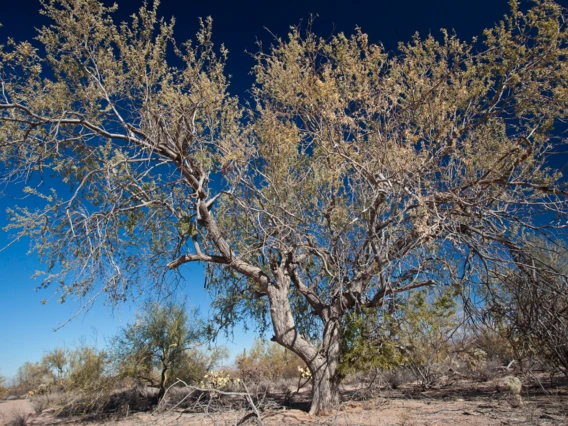Family: Fabaceae
Compound: Oln tes
Synonyms: None
Geographic Origin: extreme southwestern US, northwestern MX
Characteristics: A perennial evergreen tree with a relatively short trunk, and a broad, rounded canopy. This tree can reach 9m (30ft) in height and develop a trunk 40-60cm (1-2ft) in diameter. The bark is various shades of grey to brown and becomes furrowed with age. Younger branches have smoother bark ranging from green, to rusty brown, to grey in color and armed with small, slightly recurved, spines attached in pairs. Both twigs and leaves are covered with small grey-white hairs, that serve to protect the tree from sun damage. The foliage is evergreen except during abnormally cold winters. Leaves are even-pinnately compound, alternate with 8-21 obovate or elliptic, dull green, somewhat thick leaflets. Papilionaceous flowers appear in late spring, are 10-14mm (0.4-0.6in) across with fused filaments and a pale pink to purple corolla and yellow-white to pale pink keel. Flowers are borne on axillary 2 or more flowered racemes. Fruit are 5cm (2in), oblong or ellipitic, plump pods, with constrictions between seeds. The pod slowly dries to a dark brown color, eventually splitting in summer before monsoon rains and releasing 1-3 seeds.
Natural History: Prefers silty to gravelly soils in low desert hills and under 915m (3,000ft) in elevation. Blooms profusely in spring providing food for countless pollinators. Seeds are likely consumed by wildlife. During dry periods it will shed its leaves to hold onto water and conserve its energy for flowering and regeneration after the spring rains.
Cultivation Notes: Readily propagated from seed. When collecting and storing seeds, place them in a sealed container in the freezer for two days to prevent bruchid-beetle infestation. Fresh seeds require no treatment, but stored seeds should be treated before attempting germination. Place seeds in a jar, fill with boiling water, and leave in water for 12hrs. Seeds that have successfully imbibed moisture will be swollen and can be germinated in shallow potting mix or directly into the ground. The ideal germination temperature is 25-30C (77 – 86F). Seedlings have a strong taproot that makes transplanting difficult. Because of this, some growers recommend that seeds are sown directly in the ground (being sure to protect from pests). If sown in containers, use tall pots or deep containers and transplant into their permanent location before the taproot reaches the bottom of the container.
For general plant propagation information, click here
Citations:
Mielke, Judy. Native Plants for Southwestern Landscapes. University of Texas Press, 1993.
SEINet Arizona – New Mexico Chapter. Retrieved June 12, 2024.
Plants for Our Future. Retrieved June 12, 2024.
Useful Temperate Plants Retrieved June 12, 2024



